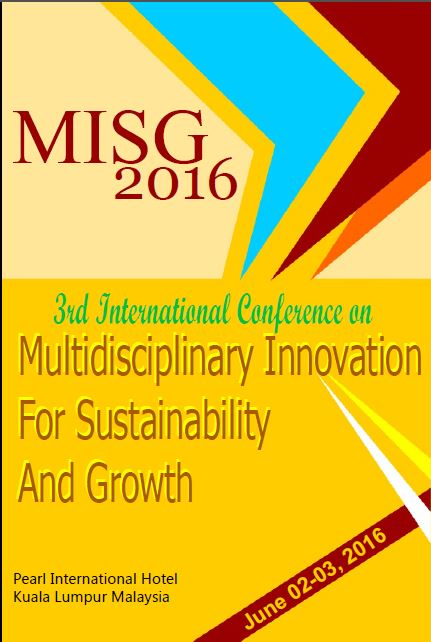
MISG Proceedings
MISG Proceeding
Volume 3, Pages 1-100
2016 MISG Conference on “MULTIDISCIPLINARY INNOVATION FOR SUSTAINABILITY AND GROWTH” (MISG 2016)
June 02-03, 2016 Kuala Lumpur, Malaysia
Edited by Dr. Ahmed Saddam
pp. 1-127 (2014)
2014 MISG Conference on “MULTIDISCIPLINARY INNOVATION FOR SUSTAINABILITY AND GROWTH”
(MISG 2014)
pp. 1-250 (2015)
2015 MISG Conference on “MULTIDISCIPLINARY INNOVATION FOR SUSTAINABILITY AND GROWTH”
(MISG 2015)
pp. 1-100 (2016)
2016 MISG Conference on “MULTIDISCIPLINARY INNOVATION FOR SUSTAINABILITY AND GROWTH”
(MISG 2016)
pp. 1-95 (2017)
2017 MISG Conference on “MULTIDISCIPLINARY INNOVATION FOR SUSTAINABILITY AND GROWTH”
(MISG 2017)
Track: Business Management & Economic Studies
A Conceptual Paper on the Study into the Effect of Organisational Innovation in Order to Survive and Grow Despite Volatility in the Global Environment
Pages 1-10
René Pellissier, Dzingai Katsamba
Abstract
In turbulent environments, like the 2008/2009 global economic crisis, companies need to deploy new process technologies and leading management practices to survive and grow. Literature suggest that firms which innovate, increase their chances of survival and growth. Growing sales and productivity are associated with incremental process innovations. There is therefore a need for organisational innovation in order to increase sales and productivity following a global crisis as it looks at both internal and external innovation. Literature also enlightened that, as the global environment becomes more and more dynamic and volatile, organisations and businesses are compelled to permanently seek the most effective models to maximise their organisational innovation management.Further review of literature revealed benefits of organisational innovation strategies, but there seems to be little work done as far as understanding whether organisational innovation can solve the impact of a global economic crisis and how this can impact on the implementation of the strategy. Some organisations may have embarked on survival strategies unknowingly borrowing from organisational innovation, while others did not. All these were clarified from an organisational innovation theoretical framework point of view.
Bank-Specific Characteristics and Technical Efficiency of Islamic Banks and Conventional Bank Islamic Windows in Malaysia
Pages 11-22
Wong Mei Foong
Abstract
Track: Social Sciences and Humanities
Neuropsychological Impact on Instructional Strategy in Inclusive Classroom in Indonesia
Pages 23-30
Rasmitadila
Abstract
Neuropsychological study of the interrelationships of the brain and human behavior will have significant impact in the instructional, especially inclusive classroom. It is important for educators to be able to teach students with a wide range of diversity, strengths and weaknesses. This article aims to provide an overview of neuropsychological impact of using instructional strategy that becomes a problem in the inclusive classroom in Indonesia. Several steps should be taken of teacher in designing instructional strategy effectively is used data neuropsychological student to identify the profile of strengths, weaknesses, disability so that it has the correct perception to meet the needs and provide interventions to students who are integrated in the instructional in inclusive classrooms with choices of effectively instructional strategy.
Regional Shaivite Sects & Centers in Paditaaraadhya Caritra
Pages 31-35
S. Chinna Reddaiah
Abstract
It is a need of the day that the age old texts and tradition of times in memorable should be brought to the new generation to improve upon the values of life. In this context early works and the descriptions of those days life and culture to be explored.
This paper intends to bring out the various shavaite pilgrim centers and sects recorded in panditaaraadhya caritra. Aaraadhya shaivam is sect of shaivism flourished in Andhra and was prophesied by twelve aacaaryas. Panditaaraadhya, is one among them. His life is depicted in “panDitaaraadhya caritra”. Palakuriki Somanatha (13th cen.) wrote many indigenous works. To put it in other words, he was the first poet in Telugu to take up indigenous theme, meter and language. His famous works “basava puranamu” and “panditaaraadhya caritra” are based on the virashaiva prophet of Karnataka basavanna and aaraadhya shaiva prophet and poet of Andhra mallikaarjuna panditaaraadhya. These two works deal with the stories of devotees in and around Andhra, Karnataka and Tamil Nadu. The heroes of these works are basavanna and mallikarjuna panditaraadhya respectively. They deal with the lives of these along with stories pertaining to other devotees of various places and the regional stories depict the presiding deity, temple or hill or place and river or tank which in turn are known as murti, stalam and tiirtham.This is an attempt to bring out such special facts. This is theory paper which deals with the early and present research on the same topic and allied ones. The paper will be in three parts exploring the poet his works and the early literature in the light of religious study. Part – I introduction of the poet and his work.(as mentioned above)
Part – II some of the shavaite sects: viirashavam, kaalaamukham, aaraadhyashaivam; devotion to shiva as omnipresent, shaiva aagamas mentioned in the text; the much and mugdha bhakti conept. Muudhabhakti – does not even regret to kill self or murder in the name of God. Mugdhabhakti – This has no reasoning. A devote can plead ideal to speak or eat for the sake of devotee.
Part – III the shaiva khestras or pilgrimage centers mentioned in the text. A brief note of the pilgrim center will be given depending on the text. For e.g. Varanasi known as banaras, sriparvatam known as srishailam. This work is a very good record of many such things related to shaivism and devotees and religion. The importance lies in the description of eight regional language singers singing in praise of Lord shiva in pilgrimage to sriparvata. The various sects found in the text are explained and the pilgrim centers.
Urban Efl Teachers‟ Motivation in Indonesia: Maslow‟s Hierarchy of Needs Theory and Herzberg‟s Motivational-Hygiene Theory
Pages 36-41
Anna Riana Suryanti Tambunan
Abstract
This paper aims at highlighting the urban EFL teachers‟ motivation in Indonesia viewed from Maslow‟s hierarchy of needs theory and Herzberg‟s motivational hygiene theory to fill a notable gap in the teacher motivation literature. Library research is used to review how motivation is essential in English teaching and learning process. The issue: teachers‟ motivation, conceptualized as job commitment and satisfaction and its relationship to teacher competency will be critically addressed. Commitment to teaching reflects the teachers‟ motivation as it is theorized that teachers to be motivated and committed to their job, they should be based on the five levels given by Maslow‟s theory; physiological, security, social, esteem and self-actualization needs. Then, Herzberg‟s motivational hygiene theory indicates that achievements, recognition, work itself, responsibility and advancement as the aspects of job satisfaction as the teachers‟ motivation affect the teachers‟ performance in the teaching and learning process. Teachers should be given the motivational factors that will positively influence their performance and productivity which will enhance quality assurance in the educational system. It can be concluded that teachers‟ motivation is a crucial factor which directly influences the teachers‟ performance, the level of student motivation and achievement
in the target language concerned.
Track: Engineering and Technology Studies
Investigation into Procedures Implemented by the Manufacturers of Concrete Masonry Rebated Filler Blocks used in Durban (South Africa)
Pages 42-50
Bonga PraiseGod Khuzwayo
Abstract
Concrete masonry rebated filler blocks form a crucial component of the beam and block slab systems. Concerns were raised by some manufacturers, engineers and users in Durban (South Africa) about the lack of basic technical and economic information with regards to concrete masonry rebated filler blocks, which form a major component of these flooring systems due to the quantities required. The lack of such information makes it difficult to identify methods of improving efficiency and effectiveness of these flooring systems in general. Hence, a pilot study was conducted in a form of a questionnaire and site visits in order to gather basic technical and economic
information with regards to the background, manufacturing, design, and possible improvements to the concrete masonry rebated filler blocks. It was found that some procedures implemented by the manufacturers of the beam and block slab systems vary depending on their personal preferences and perceptions. However, the findings on procedures created awareness and can also be used by all manufacturers as the basis for future improvements and development of better systems and methods implemented by manufacturers.
Recommended Surface Quality of a Deliberately Roughened Precast Concrete Ribs in South Africa
Pages 51-62
Bonga PraiseGod Khuzwayo
Abstract
to improve the quality of roughened surfaces for precast ribs?A literature review informed by both local and international research and recommendations was conducted. Furthermore, a pilot study in a form of a questionnaire seeking to understand the construction method was undertaken in 2013. Results were analysed and site visits undertaken in order to validate information given by the contractors.
Although the broom/brush is effective in providing a surface roughness (Rz) of 3 mm, the results are not consistent and depend upon factors such as the stiffness of bristles, cleanliness and others. Furthermore, the findings on procedures created awareness and can also be used by all manufacturers as the basis for future improvements and development of better systems and methods implemented by manufacturers.
Pilot Investigation into Common Masonry Problems in South Africa
Pages 63-77
Bonga PraiseGod Khuzwayo
Abstract
Track: Health & Medicine studies
The Implementation of Concept of Health Promotion Hospital in Indonesia
Pages 78-84
Anis Khairunnisa, Nur Arifah
Abstract
Description of Boy Teenager Food Consumption in Islamic Boarding School Immim, Makassar City, South Sulawesi 2015 (Observational Study on Field Dietetic, School Of Public Health, Hasanuddin University)
Pages 85-89
Muhamad Aryadipa Surya N, Laksmi Trisasmita, A. Imam Arundhana
Abstract
Track: Physical & Applied Sciences
Variation in Soil Physiochemical Properties at Different Land Use Sites in Northeastern Nigeria
Pages 90-100
Yusuf Mohammed Bakoji, Firuza Begham Mustafa, Khairulmaini, Osman Salleh
